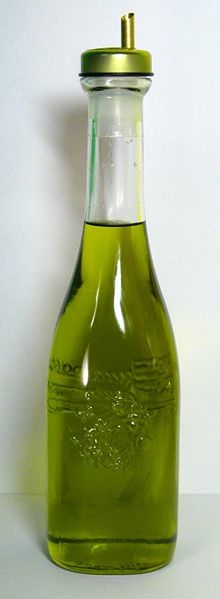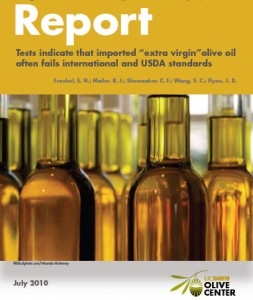
Posts Tagged: Dan Flynn
Consumers like rancid olive oil
A study conducted by UC Davis sensory scientists Claudia Delgado and Jean-Xavier Guinard found that consumers prefer rancid olive oil to the bitter and pungent olive oil favored by experts, said an article in Olive Oil Times. The findings suggest a need for consumer education to keep California olive oil in position for growth.
For the study, 110 consumers rated 22 commercial olive oils. Key findings:
- 74 percent said they disliked the oils identified as high-quality by expert tasters
- Consumers preferred oils with fruity attributes identified as nutty, ripe fruit, green tea, butter, green fruit and grassy
- 44 percent of the consumers liked sensory defects like rancidity, fustiness, mustiness and winey flavor
The story offered a few possible explanations. A large amount of defective olive oil labeled as extra virgin is available to consumers, and the bitter and pungent flavors typical of high-quality oils are an acquired taste.
Director of the UC Davis Olive Center Dan Flynn told reporter Lori Zanteson that California consumers have much to learn about olive oil flavor profiles
"A bitter profile is not necessarily bad," Flynn was quoted. “All these discussions and the availability of quality oils are contributing to this slowly growing knowledge that the consumer has.”
The research report, “How do consumer hedonic ratings for extra virgin olive oil relate to the quality ratings by experts and descriptive analysis ratings?” appears in the March 2011 issue of Food Quality and Preference journal.
In their article, Delgado and Guinard predict the California olive industry will be poised for exponential growth "as consumers learn about the many nutritional benefits and sensory qualities of extra-virgin olive oil."

Good olive oil is an acquired taste.
California olive oil production could soon be among the world's Top 10
With olive trees planted in 2008 beginning to come into production, Cooperative Extension olive expert Paul Vossen predicts this year's California olive oil crush will be the highest ever, according to an article in The Olive Oil Times.
Producers are expected to squeeze 4.5 million liters of oil from olives harvested in California.
The rapid planting-to-milling rate is a result of super-high-density planting. Traditionally, about 100 olive trees were planted to the acre. With the new system, 500 trees are planted to the acre in hedgerows, which come into production more quickly and allow for efficient mechanical harvesting.
Reporter Lori Zanteson also spoke to Dan Flynn, director of the UC Davis Olive Center. He said people are consuming more olive oil each year. Increased production in California means there are larger supplies of high quality oil to meet the demand.
In fact, high-density planting has the state's olive oil production growing at such a rate that Flynn believes California could rank among the world’s top ten olive oil producers within the decade.

Olive oil production.
USDA's new olive oil standards take effect Monday
The USDA's new voluntary guidelines defining "extra virgin" olive oil go into effect Monday, but many of California's producers are already following even stricter regulations set down by the California Olive Oil Council, according to an article in the Ventura County Star.
USDA's guidelines allow for no defects and no more than 0.8 percent free oelic acid in olive oil labeled "extra virgin;" COOC requires no defects and no more than 0.5 percent free oleic acid.
The new guidelines come on the heels of a UC Davis Olive Center study finding that of 52 bottles of 19 brands of extra virgin olive oils sampled, 32 failed to make the extra virgin cut as described in the new guidelines. The study focused on imported brands, but included two samples each of five California brands. Of the 10 California samples, one failed the extra virgin test.
Even though they are voluntary and there is uncertainty over how or even whether they will be enforced, executive director of the UC Davis Olive Center Dan Flynn welcomes the new national guidelines.
“This is an important first step, because the current guidelines date back to 1948 and are irrelevant to the way olive oil is marketed today," Flynn was quoted in the story. "Instead of ‘virgin’ and ‘extra virgin,’ they use terms like ‘Grade A Fancy,’ as though you were talking about cans of fruit cocktail. It’s a consumer-protection issue."

Olive oil.
Olive oil research well publicized by media
A research report released Wednesday by the UC Davis Olive Center received a tremendous amount of publicity, including articles in the Los Angeles Times, the San Francisco Chronicle and the Associated Press. Google News turned up two dozen stories.
In a nut shell, the report said 69 percent of imported "extra virgin" oils and ten percent of domestic "extra virgin" oils researchers analyzed did not meet the international standards that define the pure, cold-pressed extra virgin olive oils.
"Consumers, retailers and regulators should really start asking questions," the AP story quoted Dan Flynn, the Olive Center's executive director.A problem with olive oil marketed in the U.S. is that labeling lower-quality olive oil as top-end is technically legal because there are no federal rules that define "virgin" or "extra-virgin" olive oil.
The UC Davis news release said that, before this study, scientists had anecdotal reports of poor quality olive oil being sold as extra virgin.
“Now there is empirical proof," Flynn was quoted.
The LA Times story said the results of the UC Davis study were as complicated as the olive oil business itself. Some brands had samples that failed in all three geographical locations. In other cases, the same brand of oil purchased at different locations had different outcomes.
The Olive Oil Times posted a story yesterday questioning some of the new study's results. The article said that, according to the report’s appendix, the Bariani olive oil that failed the sensory testing was purchased and tested well after the “best before” date.
The 12-page report and 207-page appendix are available for free download from the Olive Center website.

Many olive oils are incorrectly marketed as "extra virgin."
Olive Oil Times touts UC Davis Olive Center
An industry blog on the website Olive Oil Times devoted a lengthy post to the UC Davis Olive Center this week. The center, established two years ago, is part of the Robert Mondavi Institute for Wine and Food Science.
In the post, writer Sophia Markoulakis noted that acreage of California olive trees for oil has increased from 6,000 in 2004 to 22,000 in 2009.
"And with California producing 99 percent of the nation’s olive oil, the UC Davis Olive Center is ground zero for ongoing olive industry research and outreach," Markoulakis wrote.
The post included comments from the center's executive director Dan Flynn, who told the writer he is pleased with consumers’ growing enthusiasm for olive oil and growers' dedication.“Being out there with those in the industry to find out their needs and how the university can help better serve them is a unique position that the Olive Center is in," Flynn was quoted. "We are the conduit between the university and the industry."
In the future, Flynn plans to develop a collaboration between table olive and oil olive growers.
“Up until now they have operated separately and I think they realize that they have to work together. They are both facing overseas competition”, the post quoted Flynn.

Dan Flynn